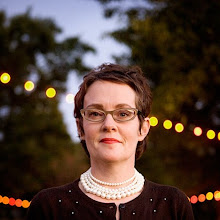
Yoshitomo Nara show at the Institute of Visual Arts (inova), Milwaukee, 2006. photo courtesy inova.A friend brought this recent article in the New York Post to my attention--it's as if someone has been tracking me, like some caribou in the Arctic Circle.
New York Post "Urban Renewal", September 13, 2010I have written about the different places I have lived over the past two decades: Seattle, Milwaukee, Phoenix and now St. Louis. (This excludes the big cities of New York and Los Angeles, but ignoring them makes the following point even more pointed.)
These housing acrobatics seem counter-intuitive to pursuing a "straight" path on a career ladder, but life isn't straight, is it?

Ragna Robertsdottir at Scottsdale Museum of Contemporary Art, 2007. photo courtesy SMoCA.What these cities brought me were unparalleled opportunities for professional and personal growth. How else could I have visited Belgium, Canada, Egypt, Estonia, Finland, France, Germany, Israel, Japan, Lebanon, Mexico, Morocco, The Netherlands, Norway, Portugal, South Korea, Spain, Switzerland, Turkey and the United Kingdom over the past fifteen years? Displacement is an important part of shaking up your world view.

Rebecca Belmore and Osvaldo Yero mold for work on the US / Mexico border. photo courtesy F.A.R. (Future Arts Research) @ ASU.I'm thinking about displacement because of an event last night. I was part of a celebration of the University of Missouri-St. Louis' Ferring Art and Art History Travel Program (named for Alison and John Ferring, two of the city's best philanthropists), held at
William Shearburn Gallery in the Central West End.
The event, founded by Dr. Susan Cahan formerly of UMSL, gives 10 or so students free trips to art centers around the country. Susan left in 2009 to work at Yale, and I have taken over the program in her absence. Last March I took the group to New York. I worked them to the bone for four full days--that was my goal!
At Shearburn Gallery last night, three of the 12 students talked about their experiences in NY and how it challenged them and changed them.

Ahmet Ogut work produced in PHX and part of my up-coming show with Ogut at Laumeier Sculpture Park. photo courtesy the artist, Amsterdam.It was a pleasure to hear, again, the impact the trip had on the students. I thought about the first time I set foot in New York--I emerged from the subway to see a collapsed crane strapped against the side of a skyscraper (the trigger to my dislike of cranes on buildings). I know the Ferring trip could play the same life-changing role.
Since good art is everywhere, what is important for an arts career is knowing what is happening elsewhere. Sure, you can just be interested
just in what's happening on your block, but I'm more interested in the expansive mind, not the small one. Think small
and big!
I am gearing up to organize the 2011 Ferring trip, we'll likely go to New York again because of the density of the experience. And for those students who have never been on a plane or out of St. Louis, watch out, a growth spurt is coming!
This is the great part about teaching--the change is immediately apparent. Yet part of the goal for the students when they return is to figure out how to contribute to making St. Louis vibrant by seeing the energy of other places.
Again, travel is a great teacher in the appreciation of self and others.






















































